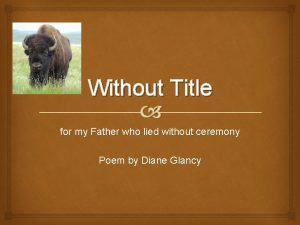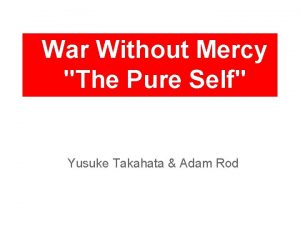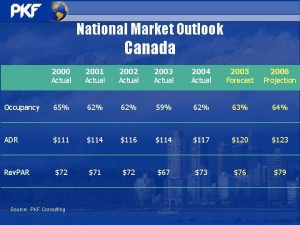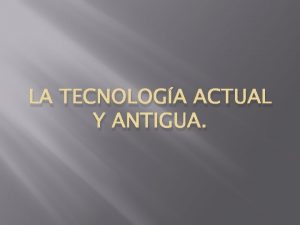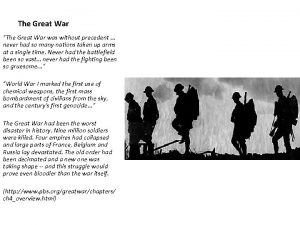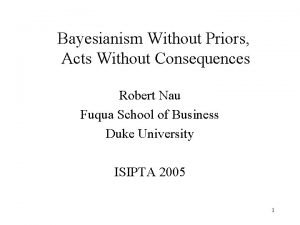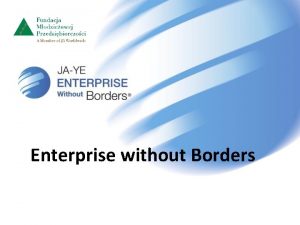C 0 LD WAR A WAR WITHOUT ACTUAL














- Slides: 14

C 0 LD WAR- A WAR WITHOUT ACTUAL COMBAT (1947 - 1991) Rather than meeting on a battlefield, the two sides built up their armed forces and tried to frighten each other.

POST WW 2/PRE COLD WAR: THE G. I. BILL �The G. I. Bill, was a law that provided a range of benefits for returning World War II veterans (referred to as G. I. s). �Benefits included low-cost mortgages, lowinterest loans to start a business, money for college tuition, high school or vocational education, and one year of unemployment compensation. �Available to every veteran who had been on active duty during the war years for at least ninety days.

THE COLD WAR ERA In February 1945, the Big Three Allied leaders Franklin D. Roosevelt (United States), Winston Churchill (Great Britain), and Joseph Stalin (Soviet Union) came together to discuss Europe’s future after World War II ended.

Death of a Leader. . . �The three leaders agreed to divide Germany into four zones each run by an allied power: United States, Great Britain, Soviet Union, and France. On April 12, 1945 President Roosevelt died suddenly, Vice President Harry S. Truman took office. Truman tried to continue with the plans created by Roosevelt. On June 26, 145 in San Francisco, California the leaders of 50 nations met (called the United Nations) tried to settle all disputes between countries and prevent wars. The United Nations could not stop trouble between the West and the Soviet Union.

JOSEPH STALIN’S PLAN… �Joseph Stalin leader of Soviet Union did not keep his promise for peace, he set up communist governments and kept Soviet military forces in Eastern Europe. �Winston Churchill leader of Great Britain feared Stalin’s actions were permanent and that an iron curtain had come down on Europe cutting off much of Eastern Europe from the West and he felt Stalin would also try to take control of other parts of the world along with Eastern Europe.

UNITED STATES RESPONDS… �Iron Curtain - symbolic division between East and West Germany during the Cold War. �President Truman along with the U. S. Secretary of State George Marshall came up with a few plans to try and stop the Soviet Union and communism from taking over countries in Europe.

DETAILS TO KNOW ABOUT THE COLD WAR �Communism was a form of government that believed that all people should share ownership of property. �Capitalism is a economic system based on private property and free enterprise. �Trade embargos prohibited trading with other countries. � The Marshall Plan gave money, supplies, machinery, and food to Western Europe after the war to help speed recovery and weaken the appeal of communism.

� Germany was eventually divided as they had planned among U. S, Great Britain, Soviet Union and France. � The capital of Germany, the city of Berlin was inside the Soviet zone. � U. S. , Britain, and France wanted to unite their zones and create the country of Germany again but Stalin of Soviet Union feared that if this happened the country of Germany would once again be a threat to Soviet Union. �At the end of 1949 the county of Germany was divided into two countries, West Germany (allied with United States, Great Britain, and France). East Germany was a communist nation tied to Soviet Union. The capital, Berlin was also divided by a wall with one side being East Berlin and the other West Berlin.

DETAILS TO KNOW RELATING TO THE DIVIDING OF GERMANY �The Berlin Wall (1961 - 1989) was a wall that divided the city of Berlin into two turning them into Berlin East and Berlin West. �NATO were a group of superpower leaders who came together to stop the spread of Communism in Eastern Europe. �Warsaw was a group led by the Soviet Union to help spread Communism throughout Europe.

HOW THE COLD WAR IMPACTED THE OLYMPIC GAMES OF 1952. �Soviet Union used the Olympic Games of 1952 to show their dominance to world as well as their own people. �Nations involved in the Cold War used the Olympic Games of 1952 to get foreign relations between the USSR and the other nations of the world.

OTHER EVENTS OF THE COLD WAR. �The Bay of Pigs was a failed military invasion of Cuba undertaking by the CIA. �Cuban Missile Crisis was a 13 day standoff over the installation of nuclear-armed Soviet missiles in Cuba.

JOSEPH MCCARTHY: MCCARTHYISM � In the political cartoon above label how each of the symbols in the picture relates to the “Red Scare” or Mc. Carthyism. Joseph Mc. Carthy �Bucket of water represents lies Mc. Carthy carries around with him spreading to people. �Fire/torch symbolizes light, meant to welcome immigrants but in cartoon represents Mc. Carthy him trying to put the fire out to discourage immigrants to come to America. �Mc. Carthy labeled hysteria represents Mc. Carthy’s beliefs about a Communist network inside the U. S. government and immigrants being spies and should not be welcomed into country

IDENTIFY EACH DEFINITION AND DESCRIBE HOW IT RELATES Definition Term. TO THE COLD WAR TENSIONS. Relation to the Cold War An argument between people or a group of people. A conflict between two Asian countries that resulted in a demilitarization line. The struggle over political differences between nations that caused a threat of war but no actual fighting. A conflict between two Asian countries that resulted in political opposition in America. The instigation of war Conflict Korean Conflict Political conflict would eventually lead to war and the death of many people. North Korea attempted to unify with South Korea and spread their Communist government war broke out and ended in a cease-fire. Cold War The Cold War caused tensions and unhealthy competition amongst nations. Vietnam War With the invasion of the Vietcong, America entered to stop the spread of Communism Proxy War causes unsettled feelings between nations and eventually war.

Foreign policies of previous presidents of the United States during the Cold War Era. - Harry Truman Created the Fair Deal to increase government spending to create jobs, build housing, and to create a health insurance policy. - Dwight Eisenhower wanted government to be smaller than bigger. - John F. Kennedy Pushed for federal aid and education for the poor in his program the “New Frontier” - Lyndon B. Johnson’s program “The Great Society” passed the Civil Rights Act, and waged a war on poverty.
 Actual-theoretical/actual
Actual-theoretical/actual Actual grace vs sanctifying grace
Actual grace vs sanctifying grace Without title poem
Without title poem Without rush without engines poetic device
Without rush without engines poetic device Without title poem
Without title poem War without mercy summary
War without mercy summary Why did josette dugas want to go to war
Why did josette dugas want to go to war Chapter 16 lesson 2 challenges to slavery
Chapter 16 lesson 2 challenges to slavery Ich war du warst er war
Ich war du warst er war Korean war vietnam war venn diagram
Korean war vietnam war venn diagram Sein war
Sein war Sides of the cold war
Sides of the cold war Lesson 1 the cold war begins
Lesson 1 the cold war begins Tug of war or tug-of-war
Tug of war or tug-of-war Chapter 30 the war to end war
Chapter 30 the war to end war


